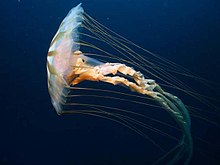
Captain Corelli's Mandolin, released simultaneously in the United States as Corelli's Mandolin, is a 1994 novel by the British writer Louis de Bernières, set on the Greek island of Cephalonia during the Italian and German occupation of the Second World War.

Fraus is a genus of moths of the family Hepialidae. There are 25 described species, all endemic to Australia.

Pelagia noctiluca is a jellyfish in the family Pelagiidae and the only currently recognized species in the genus Pelagia. It is typically known in English as the mauve stinger, but other common names are purple-striped jelly, purple stinger, purple people eater, purple jellyfish, luminous jellyfish and night-light jellyfish. In Greek, pelagia means "(she) of the sea", from pelagos "sea, open sea"; in Latin noctiluca is the combining form of nox, "night"", and lux, "light"; thus, Pelagia noctiluca can be described as a marine organism with the ability to glow in the dark (bioluminescence). It is found worldwide in tropical and warm temperate seas, although it is suspected that records outside the North Atlantic region, which includes the Mediterranean and Gulf of Mexico, represent closely related but currently unrecognized species.
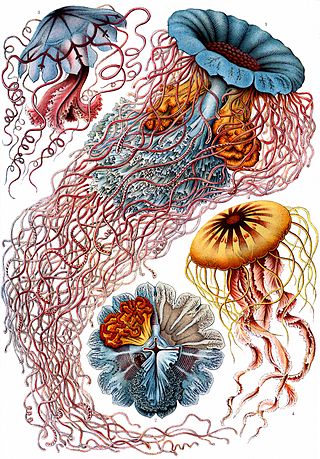
Discomedusae is a subclass of jellyfish in the class Scyphozoa. It is the sister taxon of Coronamedusae. Discomedusae contains about 155 named species and there are likely to be many more as yet undescribed. Jellyfish in this subclass are much more likely to have swarming events or form blooms than those in Coronamedusae. Discomedusae consists of two orders, Rhizostomae and Semaeostomeae.
Saint Pelagia, Pelagia of Antioch, Pelagia the Penitent or Pelagia the Harlot was a legendary Christian saint and hermit in the 4th or 5th century.

Chrysaora is a genus of jellyfish, commonly called the sea nettles, in the family Pelagiidae. The origin of the genus name Chrysaora lies in Greek mythology with Chrysaor, brother of Pegasus and son of Poseidon and Medusa. Translated, Chrysaor means "he who has a golden armament."
Amarsipus is the sole genus in the bagless glassfish family, Amarsipidae. It contains the single species Amarsipus carlsbergi, the amarsipa, which is a small and slender fish that lives in equatorial parts of the Indian and Pacific Oceans. It is found at depths from 30 to 130 m. It reaches 21.2 cm (8.3 in) in standard length. Molecular phylogenetic analysis has placed this family in the Scombriformes within Pelagiaria; however, relationships between many pelagiarian lineages are poorly resolved and the nearest relatives of Amarsipidae remain unclear.
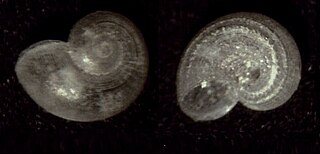
Skenea is a genus of small to minute sea snails, marine gastropod mollusks in the family Skeneidae.
Skenea pelagia is a species of sea snail, a marine gastropod mollusk in the family Skeneidae.
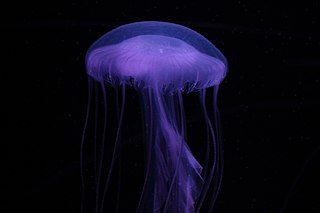
Sanderia is a genus of jellyfish in the family Pelagiidae. There are two species recognized.
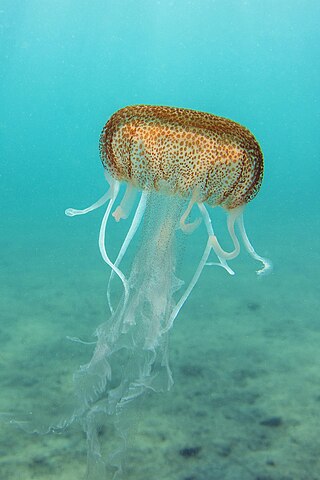
Mawia is a genus of jellyfish in the family Pelagiidae. It is a monotypic genus with the sole species Mawia benovici. The team who discovered this jellyfish named it benovici after a late colleague, Adam Benovic. Originally belonging to the genus Pelagia, it was later moved into its own genus, which was named after the Arab warrior-queen Mavia. Although described based on specimens from the Adriatic Sea, a part of the Mediterranean, it was speculated that these might be transplants rather than a part of its natural range. A later study found specimens in Senegal, indicating that its natural range possibly is the Atlantic Ocean off West Africa.
Tunicatimonas is a genus from the family of Flammeovirgaceae with one known species.

Chrysaora pacifica, commonly named the Japanese sea nettle, is a jellyfish in the family Pelagiidae. This common species is native to the northwest Pacific Ocean, including Japan and Korea, but it was formerly confused with the larger and more northerly distributed C. melanaster. As a consequence, individuals kept in public aquariums have often been mislabelled as C. melanaster. The medusae of C. pacifica typically has a bell with a diameter of 15–21 cm (5.9–8.3 in). Its sting is strong and can be dangerous to humans.

Chrysaora helvola is a jellyfish in the family Pelagiidae. Although still recognized as a valid species by the World Register of Marine Species, its taxonomic history is confusing and recent reviews of the genus have not recognized it.
Chrysaora lactea is a sea nettle in the family Pelagiidae. This jellyfish has a bell diameter of up to 25 cm (10 in), and it is native to the Atlantic coast of South America. It has also been reported from the Caribbean region, but genetic studies indicate that this population is closer to C. chesapeakei. A comprehensive taxonomic review is necessary to resolve this matter.
Chrysaora africana, the purple compass jelly, is a species of jellyfish from the family Pelagiidae. Found in the southeastern Atlantic Ocean from Gabon to the western coast of South Africa, its taxonomy has historically caused considerable confusion. Like other sea nettles, its sting is painful, but not generally dangerous unless there is an allergic reaction to the venom.
Chrysaora pentastoma is a species of jellyfish from the family Pelagiidae. This small sea nettle has a strong sting and it is found in coastal waters of eastern South Australia.
Ferrimonas pelagia is a Gram-negative bacterium from the genus of Ferrimonas which has been isolated from seawater from the Jeju Island in Korea.
Henriciella pelagia is a Gram-negative, aerobic, short-rod-shaped and motile bacterium from the genus of Henriciella which has been isolated from seawater from the Eastern Pacific Ocean.
Goezia is a genus of nematodes belonging to the family Raphidascarididae.
